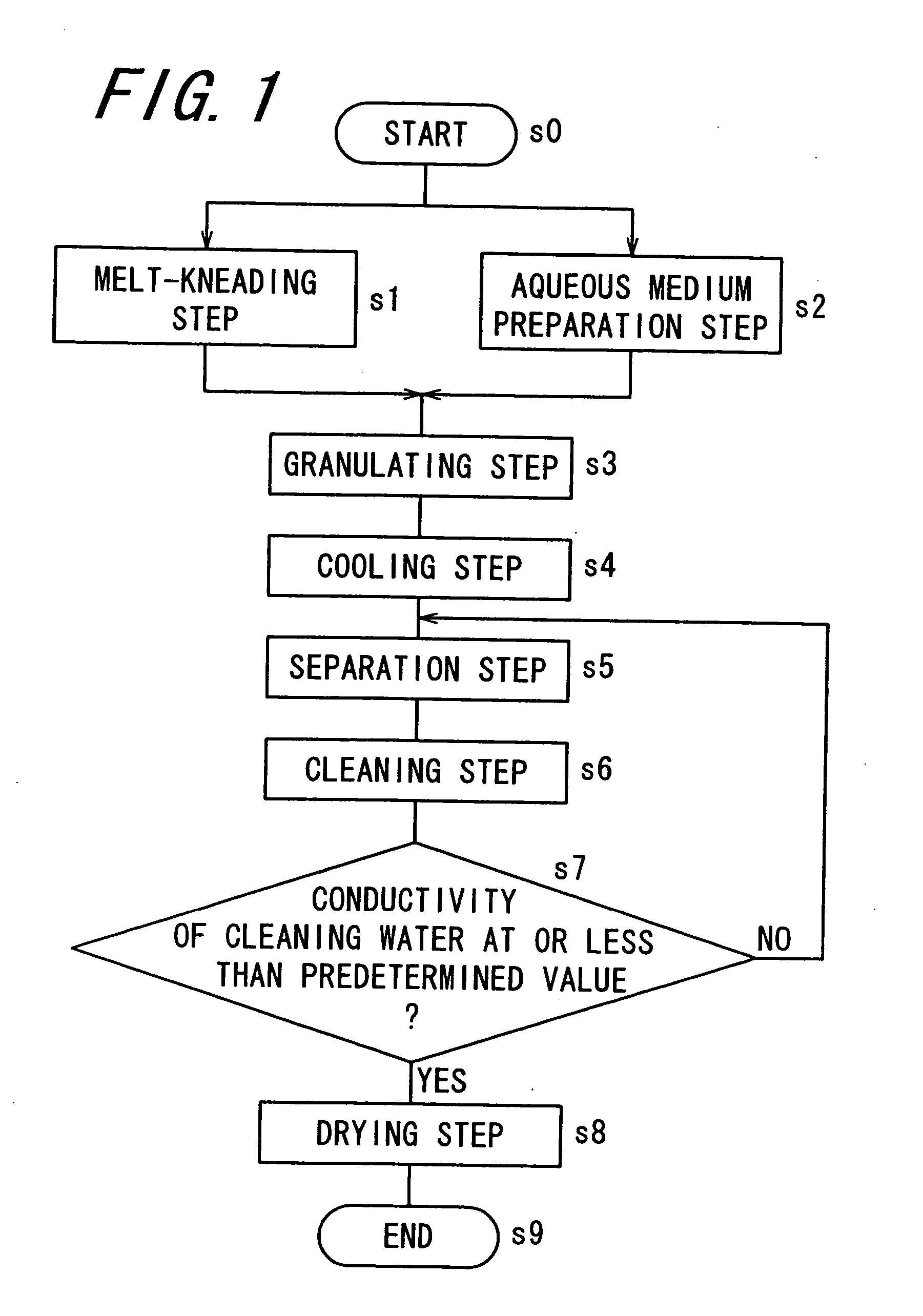Release agent, toner, and method for manufacturing same
a technology of release agent and toner, which is applied in the direction of cleaning process and apparatus, chemistry apparatus and processes, instruments, etc., can solve the problems of indefinite particle shape, image defects, and worse powder fluidity, and achieve the effect of widening the temperature rang
- Summary
- Abstract
- Description
- Claims
- Application Information
AI Technical Summary
Benefits of technology
Problems solved by technology
Method used
Image
Examples
examples
[0171] While the invention is to be described specifically with reference to examples and a comparative example, the invention is no way restricted to them. In the followings, “part” and “%” mean “part by weight” and “% by weight” unless otherwise specified.
[0172] [Softening Temperature of Releasing Compound and Resin]
[0173] The softening temperature of the releasing compound and the resin used in the following preparation examples, examples and comparative example were measured as described below. Using a flow characteristic evaluation apparatus (trade name of product: flow tester CFT-500C, manufactured by Shimadzu Corp.), one g of a specimen was inserted in a cylinder and heated at a temperature elevation rate of 6° C. / min while applying a load of 10 kgf / cm2 so as to be extruded from the die and the temperature at which one-half of the specimen was caused to flow out of the die was determined as the softening temperature. A die having 1 mm diameter and 1 mm length was used.
[0174...
preparation example
Preparation Example 1
[0192] [Preparation of Wax-Modified Polyester Resin A1]
[0193] 100 parts of a polyester resin as the reactive resin having a weight average molecular weight of 5,000, an acid value of 0 mgKOH / g, and a hydroxyl value of 55 mgKOH / g using polyethylene glycol, trimethylol propane, and adipic acid as the starting material was reacted with 85 parts of a carboxyl-terminated polyester resin as a wax as the releasing compound (manufactured by Unitika Ltd., trade name of product: ER-8101 (number average molecular weight of 2,000, softening temperature of 83° C., glass transition temperature (Tg) of 64° C., acid value of 62 mgKOH / g, and hydroxyl value of 0 mgKOH / g)) to obtain a wax-modified polyester resin A1 (acid value of 0 mgKOH / g, hydroxyl value of 3 mgKOH / g, weight average molecular weight of 9,500, side chain reactivity of 90% or more, weight average molecular weight for the side chains of 4,100, and Mb / Ma=0.82). The side chain reactivity is determined by calculation...
preparation example 2
[0194] [Preparation of Wax-Modified Polyester Resin A2]
[0195] 100 parts of a polyester resin as the reactive resin having a weight average molecular weight of 35,000, an acid value of 0 mgKOH / g and a hydroxyl value of 59 mgKOH / g, using bisphenol A, polyethylene glycol, trimethylol propane, and adipic acid as starting material was reacted with 170 parts of a carboxyl-terminated polyester resin as a wax as the releasing compound (manufactured by Unitika Ltd., trade name of product: ER-8155 (number average molecular weight of 3,300, softening temperature of 87° C., glass transition temperature (Tg) of 64° C., acid value of 37 mgKOH / g, hydroxyl value of 0 mgKOH / g)) to obtain a wax-modified polyester resin A2 (acid value of 5 mgKOH / g, hydroxyl value of 0 mgKOH / g, weight average molecular weight of 43,000, side chain reactivity of 90% or more, weight average molecular weight of side chain of 6,100, and Mb / Ma=0.17).
PUM
| Property | Measurement | Unit |
|---|---|---|
| Fraction | aaaaa | aaaaa |
| Temperature | aaaaa | aaaaa |
| Temperature | aaaaa | aaaaa |
Abstract
Description
Claims
Application Information
 Login to View More
Login to View More - R&D
- Intellectual Property
- Life Sciences
- Materials
- Tech Scout
- Unparalleled Data Quality
- Higher Quality Content
- 60% Fewer Hallucinations
Browse by: Latest US Patents, China's latest patents, Technical Efficacy Thesaurus, Application Domain, Technology Topic, Popular Technical Reports.
© 2025 PatSnap. All rights reserved.Legal|Privacy policy|Modern Slavery Act Transparency Statement|Sitemap|About US| Contact US: help@patsnap.com

